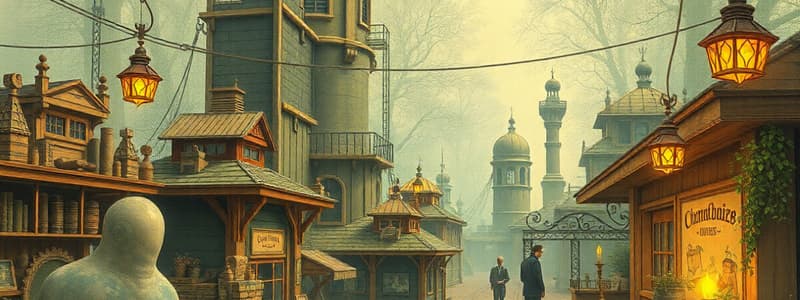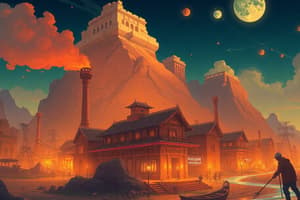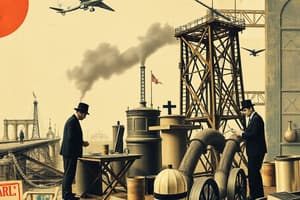Podcast
Questions and Answers
Which of the following best illustrates an investment in human capital?
Which of the following best illustrates an investment in human capital?
- A business rents office space in a commercial building.
- A company purchases new machinery to automate its production process.
- An individual attends a vocational school to learn a new trade. (correct)
- A government allocates funds for the construction of a new highway.
An entrepreneur observes that many consumers are dissatisfied with the current options for online grocery shopping. What entrepreneurial ability is best demonstrated if they start a business which offers a unique and improved service?
An entrepreneur observes that many consumers are dissatisfied with the current options for online grocery shopping. What entrepreneurial ability is best demonstrated if they start a business which offers a unique and improved service?
- Efficiently managing existing resources to minimize costs.
- Securing funding from investors for a new venture.
- Adapting a pre-existing business model to a new market.
- Identifying unmet consumer needs and developing an innovative solution. (correct)
A company uses a combination of automated machinery, skilled labor, and raw materials extracted from land to produce its goods. Which of the following resource payments would apply?
A company uses a combination of automated machinery, skilled labor, and raw materials extracted from land to produce its goods. Which of the following resource payments would apply?
- Wages, rent, and profit
- Interest, wages, and rent (correct)
- Rent, profit and interest
- Profit, interest, and wages
A local bakery decides to expand its operations by purchasing a new industrial oven. How would this purchase be classified in economic terms?
A local bakery decides to expand its operations by purchasing a new industrial oven. How would this purchase be classified in economic terms?
Which scenario illustrates the concept of scarcity in the context of labor?
Which scenario illustrates the concept of scarcity in the context of labor?
Consider a software company. Which of the following would be classified as a 'good' rather than a 'service'?
Consider a software company. Which of the following would be classified as a 'good' rather than a 'service'?
A farmer decides to use a newly discovered fertilizer that doubles the crop yield on their land. Which resource and associated payment are most directly affected by this?
A farmer decides to use a newly discovered fertilizer that doubles the crop yield on their land. Which resource and associated payment are most directly affected by this?
A small business owner invests personal savings to start a new venture. The business generates revenue, but after paying for labor, rent, and materials, there is money remaining. What is this remaining revenue classified as?
A small business owner invests personal savings to start a new venture. The business generates revenue, but after paying for labor, rent, and materials, there is money remaining. What is this remaining revenue classified as?
Which of the following scenarios best illustrates the concept of opportunity cost?
Which of the following scenarios best illustrates the concept of opportunity cost?
A country has a limited supply of crude oil. How does this scarcity directly impact its economy?
A country has a limited supply of crude oil. How does this scarcity directly impact its economy?
Which of the following is an example of a decision made based on the economic principle of optimization?
Which of the following is an example of a decision made based on the economic principle of optimization?
In the context of economics, what distinguishes 'capital' as a factor of production from 'land' or 'natural resources'?
In the context of economics, what distinguishes 'capital' as a factor of production from 'land' or 'natural resources'?
How do opportunity costs relate to the concept of scarcity in economics?
How do opportunity costs relate to the concept of scarcity in economics?
Which activity is the MOST direct example of 'entrepreneurial ability' as a factor of production?
Which activity is the MOST direct example of 'entrepreneurial ability' as a factor of production?
How does the concept of equilibrium relate to market prices in a competitive market?
How does the concept of equilibrium relate to market prices in a competitive market?
Which scenario exemplifies the use of empiricism in economics?
Which scenario exemplifies the use of empiricism in economics?
Which of the following best describes the role of households in the circular flow model?
Which of the following best describes the role of households in the circular flow model?
In the circular flow model, what is primarily determined in product markets?
In the circular flow model, what is primarily determined in product markets?
Which of the following examples represents a transaction in the resource market?
Which of the following examples represents a transaction in the resource market?
According to the circular flow model, what is the primary role of firms?
According to the circular flow model, what is the primary role of firms?
Which scenario exemplifies an economic agent making a choice?
Which scenario exemplifies an economic agent making a choice?
Which statement best illustrates positive economics?
Which statement best illustrates positive economics?
How do money flows in the resource market relate to household income?
How do money flows in the resource market relate to household income?
In the context of economic decision makers, the 'rest of the world' includes which of the following?
In the context of economic decision makers, the 'rest of the world' includes which of the following?
Which statement is an example of normative economics?
Which statement is an example of normative economics?
Which of the following questions would be studied in microeconomics?
Which of the following questions would be studied in microeconomics?
What is the most important resource market?
What is the most important resource market?
Which of these scenarios illustrates the economic principle of optimization?
Which of these scenarios illustrates the economic principle of optimization?
Which statement accurately describes the interdependence between product and resource markets, as illustrated in the circular flow model?
Which statement accurately describes the interdependence between product and resource markets, as illustrated in the circular flow model?
Which situation best represents an economic equilibrium?
Which situation best represents an economic equilibrium?
What does empiricism emphasize in economics?
What does empiricism emphasize in economics?
A city is considering building a new park. Which approach reflects the principle of optimization?
A city is considering building a new park. Which approach reflects the principle of optimization?
A consumer's budget constraint illustrates:
A consumer's budget constraint illustrates:
What is the defining characteristic of an economic agent facing a trade-off?
What is the defining characteristic of an economic agent facing a trade-off?
In economics, 'opportunity cost' is best described as:
In economics, 'opportunity cost' is best described as:
What condition defines a scenario of 'equilibrium' in economics?
What condition defines a scenario of 'equilibrium' in economics?
The 'free rider problem' is MOST likely to occur in which of the following situations?
The 'free rider problem' is MOST likely to occur in which of the following situations?
Which scenario exemplifies the 'free rider problem'?
Which scenario exemplifies the 'free rider problem'?
What is the core principle of 'Empiricism' in economics?
What is the core principle of 'Empiricism' in economics?
An economist uses data to analyze whether there is a correlation between increased government spending and economic growth. This activity is an example of:
An economist uses data to analyze whether there is a correlation between increased government spending and economic growth. This activity is an example of:
Flashcards
Economics
Economics
The social science that studies how individuals and societies make choices with scarce resources.
Scarcity
Scarcity
The condition of having unlimited wants in the presence of limited resources.
Opportunity Cost
Opportunity Cost
The value of the best alternative foregone when making a choice.
Factors of Production
Factors of Production
Signup and view all the flashcards
Goods vs. Services
Goods vs. Services
Signup and view all the flashcards
Circular Flow of Income
Circular Flow of Income
Signup and view all the flashcards
Optimization
Optimization
Signup and view all the flashcards
Equilibrium
Equilibrium
Signup and view all the flashcards
Labor
Labor
Signup and view all the flashcards
Scarcity of Labor
Scarcity of Labor
Signup and view all the flashcards
Capital
Capital
Signup and view all the flashcards
Physical Capital
Physical Capital
Signup and view all the flashcards
Human Capital
Human Capital
Signup and view all the flashcards
Land (Natural Resources)
Land (Natural Resources)
Signup and view all the flashcards
Entrepreneurial Ability
Entrepreneurial Ability
Signup and view all the flashcards
Payments for Resources
Payments for Resources
Signup and view all the flashcards
Economic Agent
Economic Agent
Signup and view all the flashcards
Positive Economics
Positive Economics
Signup and view all the flashcards
Normative Economics
Normative Economics
Signup and view all the flashcards
Microeconomics
Microeconomics
Signup and view all the flashcards
Macroeconomics
Macroeconomics
Signup and view all the flashcards
Empiricism
Empiricism
Signup and view all the flashcards
Households
Households
Signup and view all the flashcards
Firms
Firms
Signup and view all the flashcards
Resource Markets
Resource Markets
Signup and view all the flashcards
Product Markets
Product Markets
Signup and view all the flashcards
Circular Flow Model
Circular Flow Model
Signup and view all the flashcards
Money Flow in Resource Market
Money Flow in Resource Market
Signup and view all the flashcards
Product Market Prices
Product Market Prices
Signup and view all the flashcards
Decision-Makers in Economy
Decision-Makers in Economy
Signup and view all the flashcards
Trade-off
Trade-off
Signup and view all the flashcards
Budget Constraint
Budget Constraint
Signup and view all the flashcards
Free Rider Problem
Free Rider Problem
Signup and view all the flashcards
Human Behavior Theories
Human Behavior Theories
Signup and view all the flashcards
Market Changes
Market Changes
Signup and view all the flashcards
Study Notes
Microeconomics and Macroeconomics
- Microeconomics studies individuals, firms, and governments
- Macroeconomics studies the whole economy
Three Principles of Economics
- Optimization: Individuals make the best choices given their available information
- Equilibrium: When everyone acts in their best interest, there is no further improvement that anyone can achieve by altering their behavior
- Empiricism: Using data to test ideas, theories, and determine relationships between economic variables
Resources
- Resources are inputs used to produce goods and services
- Four categories:
- Labor: Mental and physical effort required for a job
- Capital: Human-created resources (physical capital, like factories and tools; and human capital, knowledge and skills)
- Land: Natural resources such as water, trees, and oil
- Entrepreneurial Ability: Talent to develop new products or improve existing ones
Payments for Resources
- Wages: Payment for labor
- Interest: Payment for the use of capital
- Rent: Payment for the use of land
- Profit: Reward for entrepreneurship (revenue from sales minus costs)
Goods and Services
- Goods: Tangible items satisfying human wants; require scarce resources
- Services: Intangible items satisfying human wants; require scarce resources
Economic Decision Makers
- Households: Demand goods and services; supply labor, capital, land, and entrepreneurial ability
- Firms: Demand resources; supply goods and services
- Governments: Demand resources; supply goods and services
Markets
- Markets facilitate exchanges
- Product markets: Where goods and services are bought and sold
- Resource markets: Where resources (labor, capital, land) are exchanged
Circular-Flow Model
- Illustrates interactions between households, firms, and markets
- Shows flow of resources, products, and income among decision makers
Economic Agent
- Any individual or group making choices (consumers, firms, parents, politicians)
Positive vs. Normative Economics
- Positive economics: Analysis based on facts, data, and objective predictions
- Normative economics: Analysis based on opinions, values, or personal feelings; describes what ought to happen
Studying That Suits You
Use AI to generate personalized quizzes and flashcards to suit your learning preferences.




